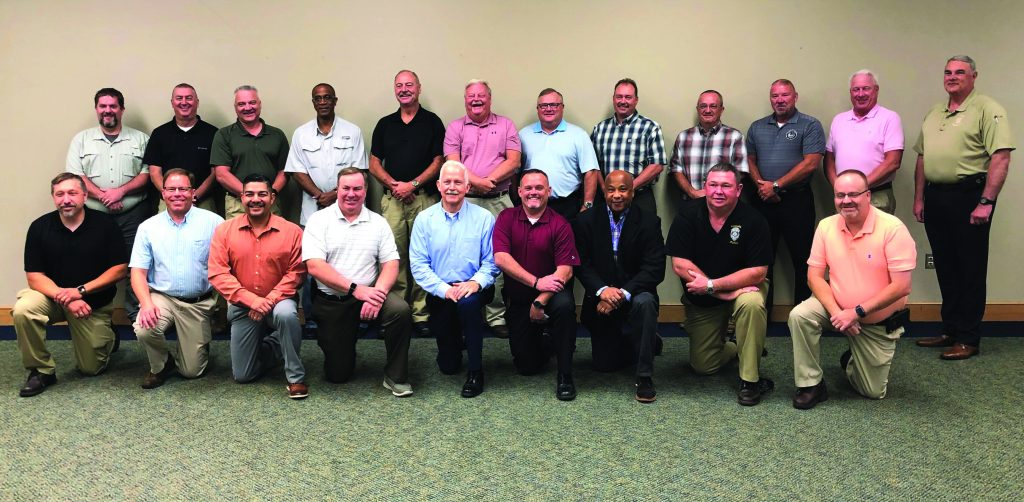
On July 30–31, 2019, the Bureau of Justice Assistance (BJA), with support from the International Association of Chiefs of Police (IACP), the U.S. Department of Agriculture’s (USDA) Office of Rural Development, the University of Tennessee Law Enforcement Innovation Center (LEIC), and the Institute of Intergovernmental Research (IIR), held the Rural Chiefs of Police Opioid Workshop in Knoxville, Tennessee.
The rural chiefs of police in attendance described their challenges and successes in tackling the opioid epidemic; discussed promising practices and solutions; and learned about different tools, programs, and funding opportunities to address this critical issue.
According to a report produced by the Centers for Disease Control and Prevention (CDC) in 2018, more than 70,000 drug overdose deaths occurred in the United States in 2017. An earlier study by the CDC, published in 2017, showed the rates of drug overdose deaths in rural U.S. communities had, in 2015, surpassed the rates of drug overdose deaths in urban areas, even though the percentage of people who reported illicit drug use was lower in rural areas than in urban areas.
Having recognized the criminal justice system’s need for assistance in responding to the opioid epidemic in rural areas, BJA’s Comprehensive Opioid Abuse Program (COAP) previously organized roundtables for judges and sheriffs. IACP was pleased to partner with BJA when they convened a workshop specifically for police chiefs.
Meeting Proceedings and Key Takeaways
The meeting kicked off with each chief in attendance describing his or her challenges and successes in tackling the opioid epidemic. One key piece of information that quickly became apparent was that while opioids are the most commonly abused drug in many of the chiefs’ jurisdictions, there was also concern about the increased abuse of methamphetamines and other drugs.
Preventing drug use for children was a key priority for these rural police chiefs seeking to break the cycle of drug abuse in their communities’ families. Most departments placed a focus on child education through Drug Abuse Resistance Education (DARE) programs as well as enhancing law enforcement’s presence in schools through school resource officers.
The chiefs generally agreed that comprehensive treatment facilities can assist in rehabilitating people in their communities, but they indicated that facilities are often hours from rural jurisdictions and frequently filled to capacity. Furthermore, in several of the jurisdictions, rural hospitals have struggled to stay open or have closed.
A reoccurring theme for these rural communities was their shared economic strife, with inadequate resources and an insufficient number of jobs. The chiefs noted that economic troubles exacerbated drug abuse in their communities, acknowledging that successful solutions would require holistic approaches involving the entire community.
Tools, Programs, and Funding Opportunities
On the second day of the workshop, BJA, USDA, and IACP informed the chiefs about relevant tools, programs, and funding opportunities available to them.
Training and Technical Assistance Resources
BJA’s COAP Resource Center: BJA’s COAP Resource Center webpage lists resources including newsletters, no-cost webinars, podcasts, articles, reports, data briefs, infographics, and toolkits. Additionally, BJA offers training and technical assistance to state, local, and tribal agencies across the United States. To request training and technical assistance, complete the online request form at www.coapresources.org/TTA.
IACP’s Collaborative Reform Initiative Technical Assistance Center (CRI-TAC): CRI-TAC provides a variety of services to law enforcement agencies throughout the United States using a cadre of subject matter experts and offering peer-to-peer consultation, training, planning, and other services to help law enforcement agencies implement cutting-edge, evidence-based practices. To request technical assistance from CRI-TAC, email CRITAC@theIACP.org. Describe the characteristics of your agency, such as size and location, and describe your challenges. The CRI-TAC team will develop a clear determination of your expectations, needs, and desired services. From there, they will work with you to develop an action plan and deliver the technical assistance solution you need.
Webinar Series: The IACP and USDA have developed webinar series on topics related to the opioid epidemic:
■ Safety and Justice Challenge Pre-Arrest Diversion (IACP)
■ Rural Health & Safety Education: Combating Opioids (USDA)
Mentor Programs: BJA has several mentor programs for which they have designated effective model law enforcement agencies and courts to act as mentors on the topics of drug courts, mental health, and diversion programs. Law enforcement agencies can submit a request to visit a mentor site. BJA funding is available to cover travel costs.
■ Mentor Adult Drug Courts
■ Law Enforcement Mental Health Learning Sites
■ Law Enforcement/First Responder Diversion Mentor Program
■ Data Gathering and Tracking Tools
ODMAP: In 2017, the Washington-Baltimore High Intensity Drug Trafficking Area (HIDTA) launched a free, user-friendly mobile tool known as the Overdose Detection Mapping Application Program (ODMAP) to track the location of fatal and nonfatal overdoses and the administration of naloxone by first responders. ODMAP provides near real-time suspected overdose data across jurisdictions to support efforts to mobilize an immediate response to a sudden increase, or spike in overdose events. An application programming interface (API) has become a popular method for agencies to contribute data without creating additional reporting. The API allows an agency or state’s record management systems to share data with ODMAP.
National Opioid Misuse Community Assessment Tool: The National Opioid Misuse Community Assessment Tool is the first-ever interactive data visualization of U.S.-wide county-level drug overdose mortality rates. Developed by the NORC Walsh Center for Rural Health Analysis for USDA Rural Development at the University of Chicago, Illinois, the tool integrates overdose mortality rates for counties in each of the 50 states with social determinants of health data such as unemployment rate, poverty rate, and disability status. Users can compare county-level information to the rest of their state and to the United States as a whole, seeing a visual representation of how the data have changed over time.
Funding Opportunities
COAP Funding: The BJA COAP Resource Center supports effective state, tribal, and local responses to the opioid epidemic. Related funding opportunities can be found at coapresources.org/ItemsOfInterest/FundingOpportunities.
USDA Rural Development Funding: USDA Rural Development provides Funding Resources for Substance Use Disorder and Opioid Misuse Prevention, Treatment, and Recovery. These funding opportunities focus on infrastructure, technology, and equipment. For law enforcement, these grants can fund naloxone/Narcan; body-worn cameras; police vehicles; or building renovation, expansion, or construction, among other items.
All Federal Resources: In addition to their own funding opportunities, the USDA Rural Development created a complete guide of all federal resources, including federal agencies that can assist rural communities in addressing substance abuse. The guide is titled Federal Resources for Rural Communities to Help Address Substance Use Disorder and Opioid Misuse.
Conclusion & Looking Ahead
Most of the chiefs in the room had at least 30 years of experience in law enforcement, yet this meeting was their first opportunity to connect with other police chiefs who were exclusively from small and rural agencies like them to discuss opioid abuse. They were appreciative of the opportunity to collaborate with chiefs facing similar challenges in areas with limited resources and experiencing economic strife. The strategies and solutions discussed at the workshop were tailored to the rural nature of the jurisdictions represented, as opposed to commonly proposed solutions that are often better suited for larger or better-funded agencies. Moving forward, the chiefs in attendance expressed a strong desire to continue sharing ideas and collaborating through quarterly phone calls. The participants were grateful that BJA convened a workshop to ensure the voices of smaller, rural agencies are heard. The IACP valued the opportunity to partner with BJA and other stakeholders and greatly benefited from the perspectives shared by the participants. 🛡
|
Read “BJA COAP Sponsors National Survey of Front-End Diversion Programs” by Karen Maline. |
Notes:
1 Lawrence Scholl et al., “Drug and Opioid-Involved Overdose Deaths—United States, 2013–2017,” MMWR Morbidity and Mortality Weekly Report, 2019, 67:1419–1427.
2 Karen A. Mack et al., “Illicit Drug Use, Illicit Drug Use Disorders, and Drug Overdose Deaths in Metropolitan and Nonmetropolitan Areas—United States.” MMWR Surveillance Summaries, 2017, 66 (no. SS-19): 1–12.
3 Office of National Drug Control Policy, U.S. Department of Agriculture, Federal Resources for Rural Communities to Help Address Substance Use Disorder and Opioid Misuse (2018).


